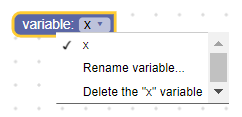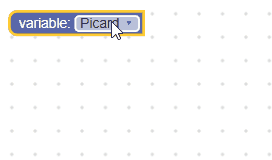Un campo variabile memorizza una stringa come valore e una stringa come testo. Il valore è un ID di una variabile, mentre il testo è il nome di una variabile.
Campo variabile

Campo variabile con l'editor aperto

Campo variabile nel blocco compresso

Creazione
Senza tipo
JSON
{
"type": "example_variable_untyped",
"message0": "variable: %1",
"args0": [
{
"type": "field_variable",
"name": "FIELDNAME",
"variable": "x"
}
]
}
JavaScript
Blockly.Blocks['example_variable_untyped'] = {
init: function() {
this.appendDummyInput()
.appendField('variable:')
.appendField(new Blockly.FieldVariable('x'), 'FIELDNAME');
}
};
Digitato
JSON
{
"type": "example_variable_typed",
"message0": "variable: %1",
"args0": [
{
"type": "field_variable",
"name": "FIELDNAME",
"variable": "x",
"variableTypes": ["Number", "String"],
"defaultType": "Number"
}
]
}
JavaScript
Blockly.Blocks['example_variable_typed'] = {
init: function() {
this.appendDummyInput()
.appendField('variable:')
.appendField(new Blockly.FieldVariable(
'X',
null,
['Number', 'String'],
'Number'
), 'FIELDNAME');
}
};
Il costruttore di variabili accetta un nome di variabile facoltativo, un validatore facoltativo, un array facoltativo di tipi di variabili e un tipo predefinito facoltativo.
- Il nome della variabile deve essere una stringa. Questo sarà il nome della variabile iniziale contenuta nel campo. Se è null o undefined, verrà generato un nome univoco.
- I tipi di variabili devono essere un array di stringhe. Indica al campo i tipi di variabili che può contenere (ovvero i tipi di variabili da aggiungere al menu a discesa). Se è null o undefined, verranno accettati tutti i tipi di variabili (e aggiunti al menu a discesa).
- Il tipo predefinito deve essere una stringa. Questo valore verrà utilizzato durante la creazione del modello di variabile iniziale del campo. Se è definito, deve essere incluso nell'array dei tipi di variabili. Se è null o non definito, questo valore viene impostato come stringa vuota, il che significa che la variabile iniziale sarà tipizzata in modo flessibile.
→ Per ulteriori informazioni sul controllo dei tipi, vedi Controlli dei tipi.
Serializzazione
JSON
Il JSON per un campo variabile è simile al seguente:
{
"fields": {
"FIELDNAME": {
"id": "QJD^+@[RVIwbLSZoDb:V"
}
}
}
Dove FIELDNAME è una stringa che fa riferimento a un campo variabile e
il valore è l'ID della variabile a cui fa riferimento il campo.
Se utilizzi questo campo nella casella degli strumenti, puoi anche specificare direttamente il nome e (facoltativamente) il tipo, poiché non sarà disponibile alcuna variabile a cui fare riferimento.
{
"fields": {
"FIELDNAME": {
"name": "my_variable",
"type": "string"
}
}
}
XML
L'XML per un campo variabile è simile al seguente:
<field name="VARIABLE" id="QJD^+@[RVIwbLSZoDb:V" variabletype="">name</field>
- L'attributo
namedel nodo contiene una stringa che fa riferimento a un campo variabile. - L'attributo
iddel nodo contiene l'ID della variabile a cui fa riferimento il campo. - L'attributo
variabletypedel nodo contiene il tipo di variabile.variabletypesegue le stesse regole del parametro di tipo predefinito del costruttore. - Il testo interno del nodo è il nome della variabile. Il valore del testo interno segue le stesse regole del parametro del nome della variabile del costruttore.
Creazione di un validatore di variabili
Il valore di un campo variabile è una stringa, quindi tutti i validatori devono accettare una stringa e
restituire una stringa, null o undefined.
Ecco un esempio di un validatore che accetta solo alcune variabili predefinite come
opzioni. Queste variabili devono essere definite con la funzione
Workspace.getVariableMap().createVariable
quando viene caricato lo spazio di lavoro.
function(newValue) {
var validIds = ['Worf', 'Riker', 'Picard'];
if (validIds.indexOf(newValue) == -1) {
return null;
}
return newValue;
}


